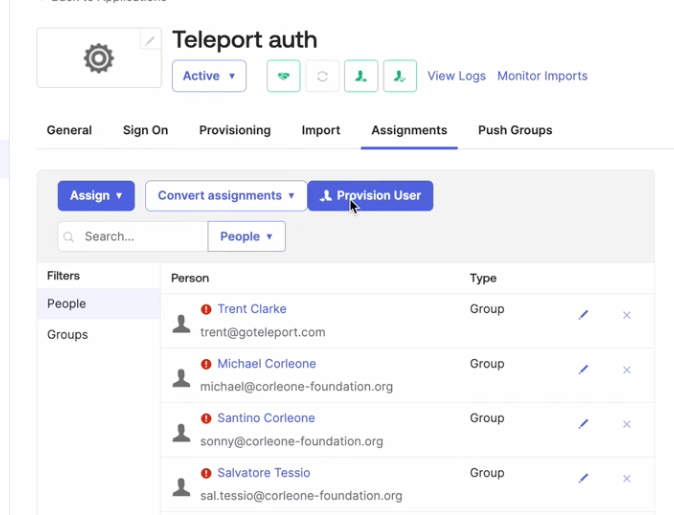Installing the SCIM-Only Okta Integration
The SCIM (System for Cross-domain Identity Management) integration enables automated user management, ensuring that user accounts in Teleport are synchronized with the corresponding Okta user profiles. This integration streamlines the onboarding and offboarding process by automatically creating, updating, and deleting Teleport user accounts in response to changes within the Okta organization. SCIM Teleport integration allows immediate locking of users in Teleport when they are deprovisioned in Okta, stopping all ongoing user Teleport sessions to maintain security and compliance.
How it works
User provisioning (and de-provisioning) with SCIM requires two Teleport components working together:
- A SAML Connector that provides SSO login to Teleport for upstream Okta users
- A Teleport SCIM plugin integration that provisions and de-provisions Teleport user accounts in response to changes in the upstream Okta organization
Both of these Teleport components rely on an Okta SAML application to act as the interface between Teleport and Okta. For consistency, both of the Teleport components must use the same Okta application.
When a user is assigned to the Okta app, either directly or via group membership, a corresponding Teleport user account will be created. If the Okta user already has a valid temporary Teleport SAML user account (i.e. they have logged into the cluster via SAML SSO before SCIM provisioning was enabled), the temporary account will automatically be adopted by the SAML integration and promoted to a long-lived SCIM-managed account.
Currently none of the SCIM user profile traits are stored in the Teleport user, although this may change in future.
When a user is unassigned from the Okta app, or is deactivated by the Okta admin, Teleport will immediately delete the user in question, and create a lock that will both immediately terminate any existing sessions and prevent that user from re-using any credentials that have already been issued. This lock will be automatically revoked if the user is subsequently re-provisioned via SCIM, otherwise the lock is permanent and will have to be explicitly deleted to remove.
Okta does not send SCIM updates to Teleport when a user is merely suspended. Even though Okta will prevent a suspended user from logging back into the cluster, any existing sessions will not be terminated, and any pre-issued credentials will be valid for their normal lifetimes.
Prerequisites
-
A running Teleport Enterprise cluster version 17.1.6 or above. If you want to get started with Teleport, sign up for a free trial.
-
The
tctladmin tool andtshclient tool.Visit Installation for instructions on downloading
tctlandtsh.
Step 1/2. Installing the Teleport SCIM integration
Teleport supports two SCIM integration modes:
- Without API token - User traits to role mapping will be propagated when the user logs in to Teleport. As a side effect, user roles will be visible and updated when users log in to Teleport.
- With API token - User traits to role mapping will be propagated immediately during SCIM user provisioning.
Run the following tctl command to install the SCIM integration.
- Without API token
- With API token
tctl plugins install okta \ --org https://trial-12356.okta.com \ --saml-connector "${SAML_CONNECTOR_NAME}" \ --no-users-sync \ --no-accesslist-sync \ --no-appgroup-sync \ --scimSuccessfully created Okta plugin "okta"
SCIM Base URL: https://teleport.example.com:443/v1/webapi/scim/oktaSCIM Identifier field for users: userNameSCIM Bearer Token: 1234567891234567891234567890
tctl plugins install okta \ --org https://trial-12356.okta.com \ --saml-connector "${SAML_CONNECTOR_NAME}" \ --no-users-sync \ --no-accesslist-sync \ --no-appgroup-sync \ --scim--api-token="${OKTA_API_TOKEN}"Successfully created Okta plugin "okta"
SCIM Base URL: https://teleport.example.com:443/v1/webapi/scim/oktaSCIM Identifier field for users: userNameSCIM Bearer Token: 1234567891234567891234567890
Step 2/2. Configuring the Okta app
To leverage the Teleport SCIM integration, you need to enable SCIM provisioning in your Okta app, which will propagate user management changes to Teleport. For detailed instructions on configuring SCIM provisioning in the Okta app, see the Okta Integration Configuring SCIM provisioning guide.
If your Okta app has assigned users before SCIM provisioning is enabled, you will need to trigger their provisioning explicitly. This can be done by selecting the Provision Users button on the Okta app Assignments page.

We have seen some Okta instances that are missing the Provision Users button. In that case the best way we have found to force user provisioning is to remove and re-add the users to the app. Triggering a Force Sync in the Provisioning/To App panel may also work, but we have had only intermittent success.
Hiding profile data from Teleport
If you have data in your Okta user profile that you don’t wish to share with your Teleport cluster, you can edit the Okta application User profile to present Teleport with a subset and/or mapped version of the full User profile.
Deleting the SCIM integration
You can delete the SCIM integration via the Integrations page in the Teleport UI, or with tctl like so:
tctl plugins delete okta
Any users provisioned by the SCIM service will be not automatically deleted along with the SCIM plugin.
You can semi-manually delete all SCIM-provisioned users using a combination of tctl and jq.
For example:
tctl get users --format=json \ | jq '.[] | select(.metadata.labels["teleport.dev/origin"] == "okta") | .metadata.name' -r \ | xargs -L 1 tctl users rm